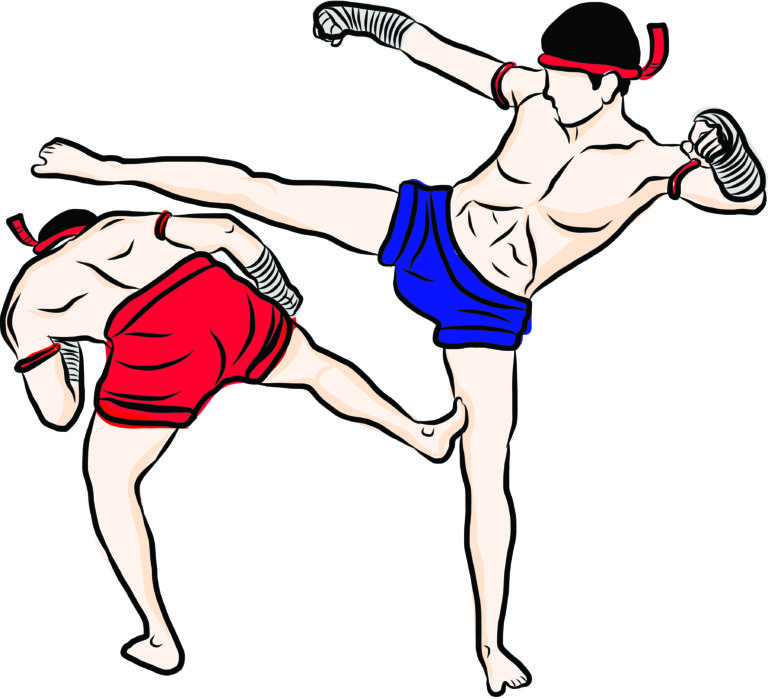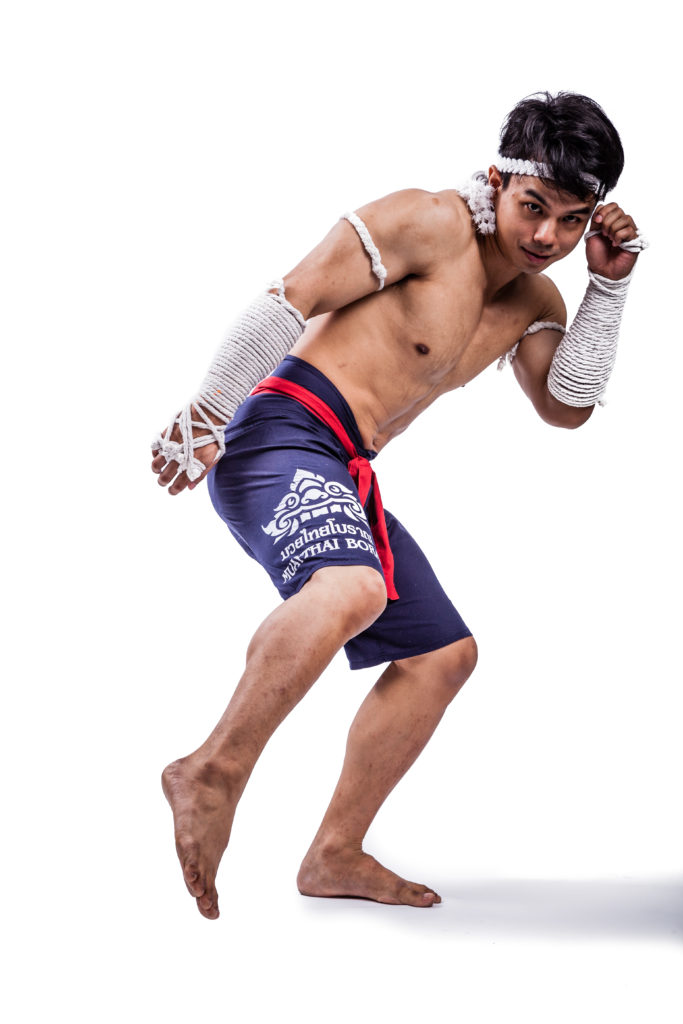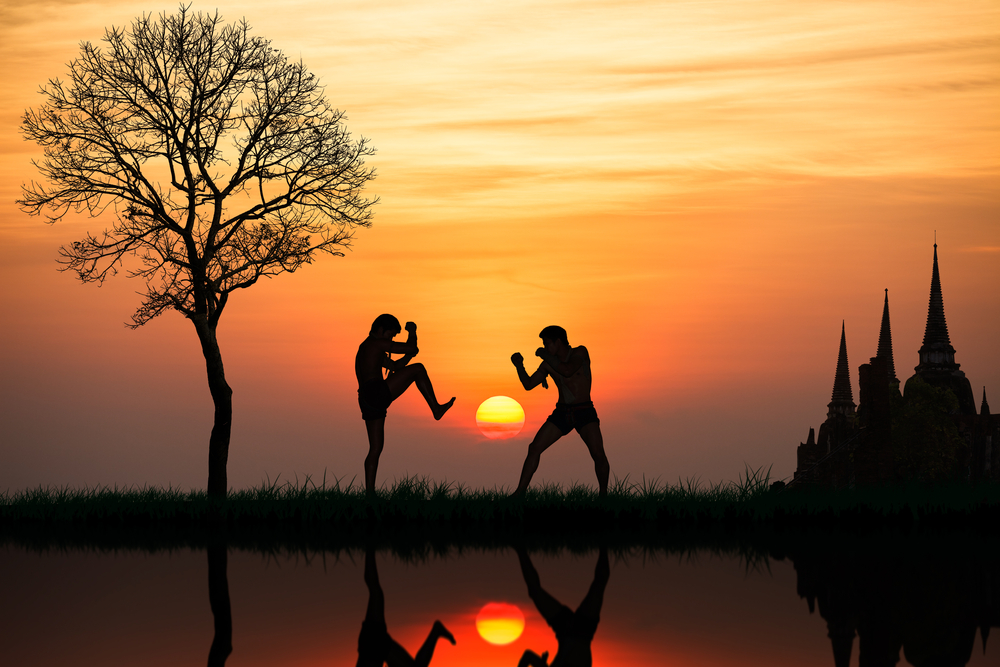Muay Thai Chaiya or Muay Chaiya is one of the styles of Muay Boran that originated from Siam or the historical area of Thailand.
It is one of the ‘mother styles’ to modern muay thai that is displayed in the fighting stadiums of Lumpinee and Rajademnern.

It is recognized that each District within Thailand has its own uinique style of muay boran or old Thai boxing style.
Muay thai chaiya is recognized as coming from Southern Thailand in the Chaiya District, Surat Thani province.
Muay Thai Chaiya Origins
Muay Chaiya is thought to have gained prominence in the time of King Rama V.
There are some differing stories on the origins of muay thai chaiya but the recognized founder of Muay Thai Chaiya is Por Tun Mah.
Por Tun Mah was warrior monk who lived in ancient Siam (Thailand) around 200-300 years ago.
The story goes that Por Tun Mah was a monk who travelled to Southern Thailand, specifically to the District of Chaiya.
In the village of Pum Riang, Por Tun Mah helped the village by capturing and taming a wild elephant (some stories say a group of wild elephants) that was damaging farms in the area.
A temple was built in the village in honor of Por Tun Mar’s success.

The temple was named Wat Thung Chap Chang, ‘The temple of the Captured Wild Elephant’.
Por Tun Mah became the abbot of the temple and taught his style of ‘boxing’ which became Muay Thai Chaiya.
Characteristics of Muay Thai Chaiya
1. Low level kicks and attacks
Muay Chaiya is characterized by low level kicks with short precise trajectories.
Smooth and effective defensive moves and counter-striking with the arms are also a major characteristic of this style.
Attacking the opponents legs quickly and causing a lot of damage is also key in this style.
2. Self defense focus
An interesting philosophical aspect of Muay thai Chaiya is to become like a ‘durian’ fruit in Asia with its many protruding and harmful spikes.
Chaiya is also known as the Durian fruit style.

The focus of Chaiya is to develop a dangerous defense that hurts your opponents with solid blocks using arms, knees and elbows.
When you strike a Muay Chaiya fighter, the only targets in range are his shins and elbows which can be very painful and damaging to the hands, arms and wrists.
The sport focus of modern muay thai is totally different to Chaiya that focuses on real world self defense techniques and using deadly joint-locks as well as weapons defense.
3. Stance and Footwork focus
In Muay thai chaiya a heavy emphaisis is placed on the fundamentals of stance and footwork. These basic movemetns are practiced over and over and over again until they become second nature.
A notable Muay Thai Chaiya master and teacher, Kru Lek states that he practiced only stance and footwork for three months before learning and attacks.

This was also to test Kru Lek’s patience and determination and dedication to learning the art of Muay Thai Chaiya.
Martial arts adventurer, Antonio Graceffo shares his experience of drilling the fundamentals of stance and footwork in an artile:
“After about a month of training [stance and footwork], I was finally allowed to kick the bag, but it was obvious that I wasn’t ready. So, I went back to doing the steps and exercises.”
4. Simultaneous Attack and Defense
Chaiya Master Kru Lek teaches that, “simultaneous defense & counterattack means protecting one’s self while allowing pain to bounce right back to the opponent”.
Kru Lek describes the 4 “BPs” of Chaiya as being the foundation of a good defense and swift and simultaneous counter attack. The BP’s described by Kru Lek are:
- “BPONG” – protect
- “BPID” – close
- “BPUD” – deflect
- “BPERD” – open
5. ‘Borrowing’ the opponents energy
Diverting, deflecintg and shifting angles allows the Chaiya practitioner to efficiently block and divert an opponents attack to be able to strike them back.
For high level Chaiya practitioners and Master’s, ‘borrowing’ the opponents force so they hurt themselves is key.
This is done by using the strongest bones in the body to block against attacks. To visualize this, imagine hitting yourself into an edge of a table.
The harder the opponents attacks the harder the counterattack they receive back.
Antonio Graceffo describes Chaiya movements as being based on a ‘rocking horse’. And by picoting and shifting the torso effective defense and counterstrikes work best.
6. Strength and Toughness not Required
In comparison with modern muay thai where emphaisis is placed on physical conditioning and strength and power and toughness – Chaiya is focussed on finishing a fight as quickly.
Finishing the fight as quickly as possible also means taking very little damage through having excellent defense, shifting pivoting and counterstriking.
Where Can I Train Muay Thai Chaiya?
There are several excellent resources to learn and train muay thai chaiya both in person and online.
Below are some of my recommendations.
1. Kru Lek
You can learn more about Kru Lek and access video training resources at https://muaythaichaiyatraining.com/en/index.html
There is also the Kru Lek Vimeo series at https://vimeopro.com/muaythaichaiya/muay-thai-chaiya-techniques
He is a true MAster of Chaiya as well as other Thai traditional arts such as puppetry.
If you re lucky enough to train in person, Kru Leks at Baan Chang Thai and you can find prices for his courses at http://www.samkhum.com/en/courses.php
2. Nathan Brown
Another excellent resource to learn in your own time at home is the YouTube channel by Nathan Brown where you can learn the basics.
You can learn more advanced Chaiya and access his full curriculum at www.LearnMuayChaiya.com
3. Kru Preang
Kru Praeng is an instructor of of the Chaiya style with over 30 years of experience teaching martial arts in Thailand.
Kru (teacher) Preang, was the close student of Kru Thong Chuer-Chaiya and traces his lineage back to Phraya Wajeesatayarak, the provincial governor of Chaiya.
http://muaychaiya.com/
4. https://www.nutty-adventures.com/
You could also try out a travel tour to Southern Thailand with Nutty Adventures.
Learn about the traditional style of Thai boxing known as Muay Chaiya and its deep roots in Thai culture. Get some good exercise yourself as you learn the basics of Muay Thai, which is Thai boxing as it is generally recognised today. At the same time you will be enjoying the warm hospitality of the friendly local people and have a chance to go out with the local fisherman and learn something about their way of life.
https://www.nutty-adventures.com/thailand-tours/south-thailand-tours/secrets-of-muay-thai-chaiya/



